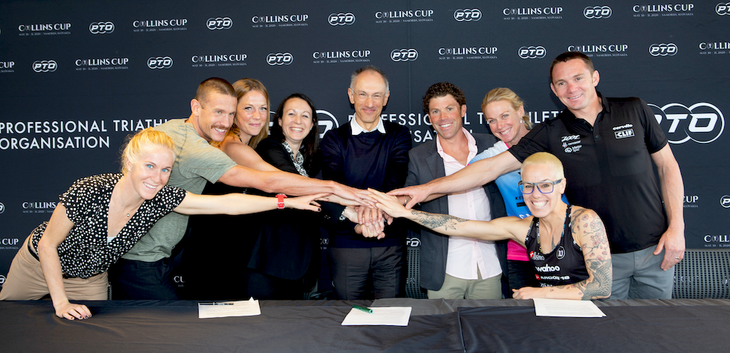New perk! Get after it with local recommendations just for you. Discover nearby events, routes out your door, and hidden gems when you sign up for the Local Running Drop.
First, some history. In 2015, a group of triathletes announced the formation of the Professional Triathletes Union, representing all non-drafting pros. The union was meant to create a collective bargaining voice, but eventually disbanded over disagreements about membership fees and goals. The Professional Triathletes Organization (PTO) formed in its place as a partnership among several pros rather than a legal union, and announced a flagship race called the Collins Cup four years ago. The event, described in more detail below, was meant to make long-course racing exciting and salable to the masses, turning its athletes into household names. But the race never got off the ground and the PTO sat dormant, waiting for the right investor to kickstart its vision.

That investor has arrived, in the form of venture capitalist Mike Moritz.
This week, the PTO announced major investment from Moritz — well known for his work with Sequoia Capital, which invested early in Google, PayPal, and Youtube. Although the exact amount of Moritz’s investment in the PTO is undisclosed, inferring from pitch decks that were circulating among pro athletes suggests it is at least somewhere in the $10-20 million range.
The money will first fund a $2 million prize purse for the Collins Cup this spring and a broadcast with “seven figures” being spent on production, according to Charles Adamo, chairman of the PTO. It has not yet been determined if that broadcast will be streaming behind a paywall or online for free or broadcast on TV.
Although the Collins Cup race was originally going to be held in conjunction with Challenge Roth in July, it will now be held at the end of May in Samorin, Slovakia.
The race will adhere to most of the original details laid out: There will be geographic-based teams of 12, picked via world rankings with a few additional discretionary spots. Most of those athletes have committed: Lionel Sanders, Tim O’Donnell, Holly Lawrence to name a few. The teams will have captains — Chrissie Wellington and Normann Stadler for the Europe team; Craig Alexander, Lisa Bentley, Simon Whitfield, and Erin Baker for the internationals; and Karen Smyers and Mark Allen (with Dave Scott in an honorary position) for the U.S. Three athletes — one each from the three teams — will go off in a head-to-head race. Then the next race of three will follow ten minutes later. Each match-up is contested across the half-Ironman distance and counts towards the team’s overall scores.
In the end, the largest prize purse in triathlon will be awarded, with advances already paid to the captains and to the ranked athletes who have committed to competing.
The PTO knows you’ve heard this before. They know it has an uphill battle to try to create spectator-backed pro races, with fans outside the sport tuning in to high-quality broadcasts and major sponsors signing on to the events. The organizers know it was four years ago they first promised a Collins Cup race, pitting the best pros from Europe v. USA v. the rest of the world. They know you might be skeptical. It’s failed before.
“The space is littered with carcasses of people who threw just a little bit of money at it,” Adamo said.
But this time is for real, he said. Because this time — and this is a big difference — they have a lot of money.
“I’ve been paid my advance,” said Ben Hoffman, who will compete for the U.S. team in the Collins Cup race in May. “It’s real. It’s in my bank account.”
The question that follows will be if the athletes, the investors and the organization can build off that race to fund their bigger plans. Because they definitely have bigger plans.
“You have to have a long-term view,” said Hoffman. He knows there’s skepticism. It took a lot of years of conversations happening among the pros before this effort got off the ground. Now, though, he says, “it has real possibility.” If they can “generate enough interest and excitement and not screw it up at the beginning.”

For Hoffman and the other athletes, a handful of who met with Moritz in San Francisco to officially launch the deal, the hope is it will ultimately lead to a series of races run by the PTO, with large prize purses, marketing and high-quality broadcasts that attract sponsors. And with investment and buy-in from the pros it will eventually be self-sustaining and profitable.
According to Adamo, all of the top 30 men and women in the world rankings, as determined by Thorsten Radde of TriRating.com, have signed on to the PTO.
Moritz has invested in the effort through his personal investment vehicle, not through Sequoia Capital. The PTO will operate as a non-profit organization, much like the PGA. The commercial enterprises of the PTO, like the Collins Cup and any future races to come, will be operated under a commercial entity with the PTO retaining 50% ownership and Moritz retaining 50% ownership.
The key there, said Adamo and Moritz, is the athletes (via a board) will ultimately retain partial ownership and be able to decide what to do with their 50% portion of the profits. They could reinvest in prize purses or decide to help fund medical insurance.
But becoming profitable will, at best, take some time — which is fine with Moritz.
“These sort of things require time and patience in order to build this right,” he said.
Moritz isn’t a triathlete. But he does swim and go to cycling classes with Purplepatch in San Francisco. And one day Matt Dixon, who coaches and heads up Purplepatch, suggested he talk to this guy, Charles, who was looking for investors for a new professional triathlon organization.
“My ears pricked up for a variety of reasons,” said Moritz. For one, sports are a booming investment area right now, particularly those off the beaten path, and triathlon has great demographics to attract non-endemic advertisers. Secondly, this is a time when access to broadcast is available across all kinds of platforms, and all kinds of people can be reached. And, yet, no one has really provided a truly compelling coverage product in triathlon — ie. Facebook Live video can be boring. Plus, maybe most importantly, said Moritz, you have the potential for amazing athletes to do amazing things and to sell sponsors off that — if they’re marketed better and if their stories are really told. “Here you’ve got some of the best athletes in the world and nobody knows,” he said.
“These are good investments if thought out and structured correctly,” he said.
So what will structuring them correctly entail?
One example Adamo likes to point to is golf. The players in golf organized around their own tour and ultimately make money of their own collective fame. And, in terms of numbers, well, he pointed out the LPGA events attract about 400,000 viewers.
Of course, it could be hard to get there. It’s been hard before, as shown by the last four-plus years of announcements and stops and starts. In 2015, sports agency, Wasserman, was selected to go out for sponsors and bids from host cities for the Collins Cup. They failed to solicit the necessary interest and the race never happened.
The PTO also, this past fall, released a public letter announcing its intent to purchase Ironman from the World Triathlon Corporation.
So far, Moritz’s investment is being used to hire production staff and figure out logistics. Sam Renouf, who was formerly CEO of Motiv and an executive at Active, was hired this past fall as CEO, to head up the commercial arm of the PTO. Now, said both Adamo and Moritz, it’s time to show the triathlon world what they have planned — not just talk about it.
“I certainly believe there’s potential,” said Hoffman. There will be real discussions the pros need to have — what constitutes being a professional to qualify for some of the potential money guarantees, how will this co-exist with an Ironman schedule and Kona focus. But if the top pros can come together now that there’s real money behind the venture, Hoffman believes it could work.
“Any time someone makes an investment in the sport, it’s a positive thing,” he said. “Money does talk.”
This story was been updated on 1/21/20 to clarify that the PTO is not a legal union.
